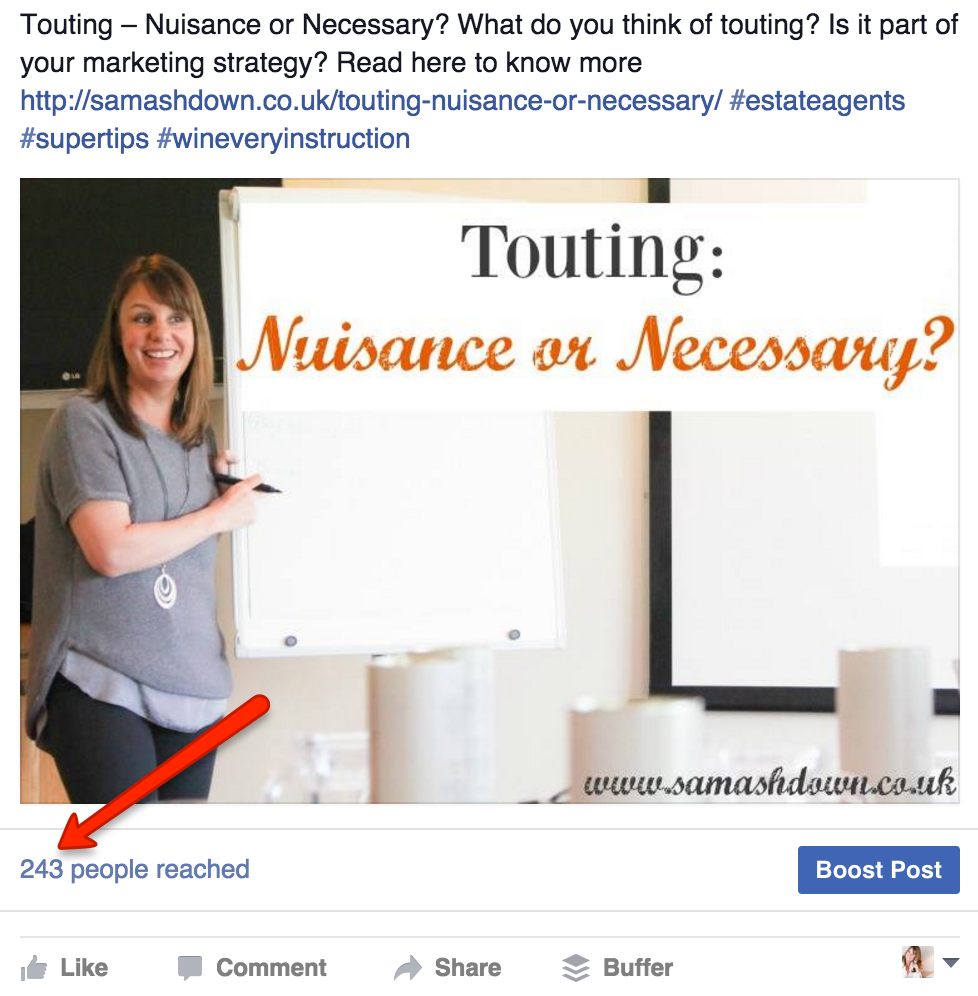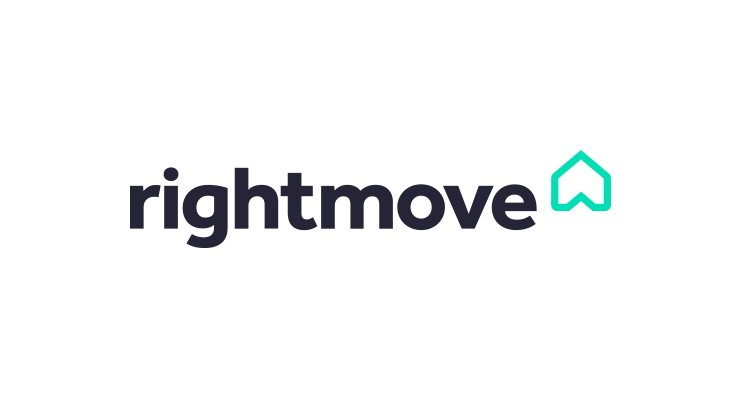SOCIAL MEDIA MARKETING FOR ESTATE AGENTS: THE DEFINITIVE GUIDE
The what, where, how, when and who of using social media to drive traffic, generate market appraisals and win instructions.
(Note: I’ve created a short video for you on Social Media Marketing here in case you want to skip the post and go right here http://samashdown.co.uk/)
“We’re spending £400 a month having our Facebook page managed; could you take a look and see if we’re doing the right thing?”
This is an email I received from a letting agent in Stoke this week. I get emails like this from agents all the time; agents who are spending hard-earned revenue on getting their social media marketing managed, with no clue of whether it’s working or not.
I looked at three metrics on her Facebook page: likes, reach and engagement.
Likes – with only 93 likes on her Facebook page, she was spending roughly £1 a week on each one. Given that the first 100 likes or so on a Facebook business page tend to be largely family and friends of you and your team, this is a large and unnecessary expense that could definitely be deployed elsewhere for a much better return.
Reach – log onto your Facebook page, and beneath every post is a number of people reached, like this:
You see, Facebook doesn’t show your likes (fans) everything you post. The 243 figure above is about 10% of my Facebook likes, meaning that 90% of the people who have liked my page have not seen this post. When I checked the reach of this agent’s page, she was getting around 6-8 people seeing each post, around 5-7%. (Facebook are reducing this reach all the time, forcing companies to pay to reach their audience.) So she was actually paying more like £10 a week to reach each like on her page. Hardly a worthwhile investment.
Engagement – this is how many likes, comments and shares you get on your Facebook posts and is a more relevant metric than reach, in some ways, as it demonstrates how connected your audience is with what you’re posting. Looking down this letting agent’s page, very few of her posts had any likes, comments or shares at all. No one cared about a feature she’d posted on how to move house successfully, or a photo of a thank you card she’d received from a happy tenant. Would you? Facebook uses the engagement activity on your page to determine the reach you get; the higher the engagement, the more people will see each update you post.
Here’s what I advised this letting agent:
- Ditch the social media manager until you can see for yourself what’s working
- Start posting stuff people actually care about
- Run a ‘like’ ad campaign in Facebook to increase relevant likes on her page
- Boost each post to reach the right audience
If she spends the whole £400 a month on Facebook ads instead of chucking it away on having the page managed, her results will be exponentially better than they are now.
Social media can be a real minefield.
What should you post? Where should you post it? Who should do the posting? How do you know if it’s working??
Social media marketing can be a fantastic way of connecting with your audience. It allows you to portray your brand message, distinctive personality and team spirit in a fun, informative and engaging way that your website can never do.
However, it can also be expensive (to outsource), confusing, potentially damaging to your reputation and hugely time-consuming.
If you’re writing any kind of content – blogposts or articles – social media gives you a megaphone to amplify it, allowing you to reach huge numbers of people instantly. And even when you pay to distribute it, it’s still currently better value for money than any other advertising channel, bar none.
Social media marketing shouldn’t be a daily grind; it needs to be a system, working constantly in the background for you, bringing in new enquiries on an automated basis. To be able to ‘set it and forget it’, here are the steps:
STEP 1 – Choose the right platforms
There’s no point in telling you that you need to be everywhere. Not only do you not have the time and budget to have a presence on every social media platform (unless you have a whole marketing department at your disposal), but you need to be selective about which platforms you choose; only choose those that you’re comfortable on, that can make the greatest impact, that fit your brand image, and most importantly, the platform where your clients are.
These are the five platforms I recommend for estate and letting agents, roughly in the order of importance and relevance:
- Google Plus
Don’t panic! You certainly don’t have to be on every one of these five platforms. This list is just designed to help you pick and choose from the main social media platforms out there. Let’s take a brief look at each one in terms of
- Personality – what is the overall tone of the platform
- Culture – what type of content is posted there, and why
- Main topics – which topics are most welcomed and shared on the platform
- Frequency of use – how often its users tend to visit
- Key formats – which content formats work best on the platform
- Best to reach – prospective vendors or landlords, or both
- Posting guide – a brief guide to formatting your content to best fit in with the style of the platform
- Potential – what’s in it for you?
1. Facebook
Personality – fun, upbeat, show off
Culture – sharing, voyeuristic, gossip
Topics – family, travel, entertainment
Frequency of use – daily, multi daily, constant
Key formats – images, videos, newsfeed ads
Best to reach – vendors
Posting guide – as if from a friend: image-rich, chatty tone, attention-grabbing
Potential – massive – assume your audience is on Facebook, and connect with them on several levels and formats. Build the relationship over time and nurture until they are ready to make that contact with you.
2. Twitter
Personality – sociable, information-seeking, FOMO (fear of missing out)
Culture – fast, short-lived, public, helpful
Topics – tech, social media, in the news, local updates
Frequency of use – multi-daily
Key formats – images, text, quotes, links
Best to reach – vendors and landlords
Posting guide – link to own and third party content with an image, post several times
Potential – huge reach and the ability to target your local issues and events with hashtags, (#) as well as find and connect with key influencers and suppliers for possible referrals.
3. LinkedIn
Personality – professional, intelligent, successful, influencer
Culture – connecting, learning, discussing
Topics – recruitment, business growth, marketing strategy
Frequency of use – daily, 2-5 times per week
Key formats – article, white paper, links to relevant articles
Best to reach – landlords
Posting guide – post blogposts or articles using LinkedIn Publisher, share relevant third party content using the status update
Potential – great for reaching your exact target audience. Premium users (currently around £40 a month subscription) can perform advanced searches to contact specific company employees and job roles. LinkedIn contains a huge depth of information about the people in your community, and you can be confident the key influencers in your industry and area are listed on there.
4. Google Plus
Personality – articulate, knowledgeable, home worker, male
Culture – supportive, learning, collaborative
Topics – social media, tech, good business practices
Frequency of use – 2-5 times per week
Key formats – blogposts, images and gifs, links
Best to reach – vendors and landlords
Posting guide – long-form content, ie best to post your article or blogpost on the platform in its entirety, with a call to action at the end, and link back to your site
Potential – Google Plus is fantastic for search engine optimisation. In other words, if you post quality content on a regular basis, your Google Plus posts will often rank higher than your website, and hopefully that of your competitor!
5. Pinterest
Personality – homely, creative, seeker, female
Culture – sharing, endorsing, adding value
Topics – home, travel, food
Frequency of use – 2-5 times per week, weekly
Key formats – high quality non-human images, infographics
Best to reach – vendors
Posting guide – post blogposts and add the link in the source url for your image (go to edit and add the link in there
Potential – I’ve used Pinterest to drive traffic to my blog, and seen a 7 x increase within the last 12 months. The platform has fantastic potential to amplify your content, though the reach can be difficult to target to your local audience, unless you post regularly about local issues.
STEP 2 – Respect the platform and the audience
“Making good content is all about respect” – so says Gary Vaynerchuck, CEO of VaynerMedia, a multi-million dollar media company, and self-styled social media guru.
Without respect for both your chosen platform and the audience you’re trying to reach, your content will get ignored and rejected, losing you credibility and market attention.
For example, if I’m browsing Pinterest in the evening, whilst watching tv and enjoying a glass of wine, I may well be in a shopping frame of mind. But if I’m on Facebook, I’m just chatting to friends and family, and in ‘nosiness’ mode. Keep in mind the mood of your audience, at that time, on that platform, and create your content with her in mind.
Your content is not about you – it’s about her. Yes, of course you would like to get her to book a market appraisal, but she’s just not going to do that whilst she’s browsing Facebook. But if you offer her an ebook or checklist called 12 Ways To Move House With Kids And Still Stay Sane, you’ll grab her attention and motivate the click by offering her something just for her.
Step 3 – Systemise
I know people who spend hours every day on social media. My guess is that you’re not one of them. You simply don’t have the time to learn the nuances and limitations of every platform, upload your content to each one, every week, and spend hours on reaching out to your audience individually.
The next step to get your content strategy working for you, not with you, is to create a system, then delegate. Let’s look at two options, in-sourcing and outsourcing.
Insourcing
Just because your admin guy is under twenty, doesn’t mean he can ‘do’ your social media. This is a knee-jerk reaction to a lack of confidence about what you should actually be doing on social media, and a feeling that at least if you’re on there, that’s half the job done. Trouble is, a half-hearted, amateur social media presence is worse than no social media presence. So you can’t just approach Joe, your admin, and tell him to update your Facebook page every day because you don’t know what else to do.
Instead, you need to create a written social media strategy and also a style guide for posting appropriately to that platform. Then, vitally, you need to allocate time and resources to allow Joe, or anyone else, to do the job properly. The time it will take depends on your posting frequency, the remit and the platforms you have chosen to develop a presence on. For example, if you decide to post on Facebook three times a day, Twitter six times, and LinkedIn once, you need to allocate at least an hour or two a day to the person responsible for doing it. You can’t just expect Joe to be able to update your Facebook page whilst he’s waiting for the kettle to boil. He needs to know you value the task, and that you’re prepared to invest in getting it right.
You also need to make sure he has the tools to do the job properly. Scheduling software, content sources and images are all necessary tools to get your social media looking professional, engaging and on-brand. Applications like Buffer, Edgar and Hootsuite will help him to schedule your posts on a consistent and frequent calendar, and allow him to batch his time for efficiency.
You need to compile a list of appropriate content sources so that Joe, or whomever, doesn’t post from the LAD Bible and other dodgy sources. You need to create a of trustworthy sources such as Rightmove and Telegraph Property, leaving Joe to post from these sites without worry he’s posting something inappropriate.
Outsourcing
An alternative to giving Joe in admin the social media strategy to follow, is to outsource your social media to an outside person or company. When pursuing this route, please, proceed with caution. The road is full of potholes and landmines, ready to sabotage your social media road trip. Things that can go wrong here include:
Getting ripped off – don’t be like the lovely but naïve letting agent paying £400 a month company update her Facebook page a couple of times a day, for only 93 likes. Know what works first, before farming it out to an outsourcer.
Getting the content wrong – if another party is going to be updating your social media, they need to know you and your brand really, really well. Posting photos of cats when you’re an upmarket sales agent in Kensington, or an image proclaiming THANK GOD IT’S FRIDAY (yes, I’ve seen this on many an agent Facebook page) is not on brand and it will leave your audience confused and even annoyed.
The language barrier – if like me, you’re considering using an overseas assistant to help you with your social media content, a word of warning: even when English is their first language (and most will claim it is), there is still a ‘nuance gap’. This is when they don’t say things in quite the way that we do here in England. You may not be able to put your finger on exactly what’s wrong (unless they slip into America-speak, like ‘awesome!’ and ‘super excited’) but it just won’t sound like you’ve written it. Because you haven’t. My solution to this is to write the updates and for my assistant to simply share them, according to a ‘Content Share Schedule’.
If I haven’t put you off outsourcing entirely, here are the main three routes to delegating your content distribution, and some ideas and tips to help you get outsourcing right:
Using a social media agency – this is usually the most expensive option. At the time I am writing this, rates are around £100 – £125 per platform per month, but actual activity ranges from say, three times a day posting on Facebook, to less than five times a week. Make sure you know exactly what you’re getting from the agency, where they will be getting their content from, and if they are simply feeding many agents the same content, or creating bespoke just for you.
Expect to pay: from £300 monthly for three platforms
Find a freelancer – at risk of being lambasted for sexism here, stay-at-home mums are often a great resource for this type of job. You can offer them flexible hours, meaning they can be at home with their children whilst still earning money doing something enjoyable and challenging. If you can find someone who used to work in marketing, or even social media campaigns, before they took a family break, you could strike gold. Consider incentivising them on metrics like engagement, followers, shares, etc.
Expect to pay £7 – £10 an hour and need around 10 hours a week
Hire an overseas assistant – this is the route I have taken. Aba, my fab virtual assistant, lives in the Philippines. She works full-time for me and the main purpose of her role is to publish, distribute and amplify my content. So I spend an hour or so a week writing my blog, and she publishes it on my blog, then distributes it on five different social media channels. Finally, she amplifies the content by sharing previous posts on a ‘content reshare schedule’, so that we are constantly posting interesting and engaging content, written by me, in all the places my audience will read them. A word of caution though; as I said earlier, I would not rely on my assistant to actually write any posts or even an update for me. I give her all the text she needs to introduce the post, to make sure the tone and style of my message sounds like me saying it.
Expect to pay $500 – $700 a month for a full time assistant
Let me help
Would you like a chat with me, one-to-one, about your social media marketing? In just 20 minutes, I can tell you what I think is working for you, and what you need to change or ditch. I only have a handful of these call spots to offer, so book your place now, before your competitor beats you to it. Just tell me about your business here, and discover how to take your social media marketing to the next level, simply and profitably.
What to read next: Three of my BEST marketing secrets, just for you







